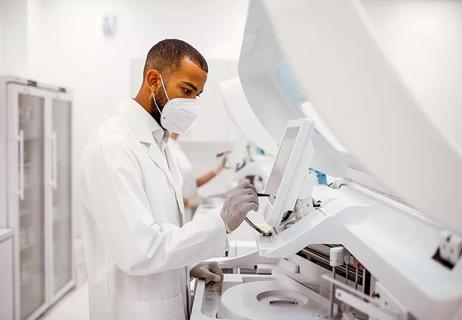Rely on trusted information from hospital systems, medical nonprofits or your oncologist

When you get a cancer diagnosis, the first thing you want to do is gather all the information you can so you’re equipped to tackle your road to recovery.
Advertisement
Cleveland Clinic is a non-profit academic medical center. Advertising on our site helps support our mission. We do not endorse non-Cleveland Clinic products or services. Policy
But a quick Google search will likely unearth more info than you might be ready for.
How do you know which treatments are right for you? How much attention should you give survival rates? And what lessons should you listen to when it comes to tackling your own diagnosis?
This process can be especially confusing for anyone who receives a diagnosis for rare cancers like cholangiocarcinoma (bile duct cancer). Oncologist Suneel Kamath, MD, explains ways to avoid falling down a rabbit hole of misinformation and provides help for recognizing credible sources.
Before you dive into your next online search, here are some tips to improve your search results and offer you better support during this difficult time.
Not all cancers are created equally.
Bile duct cancer is a rare cancer that affects about 8,000 people in the U.S. every year. Bile, the fluid that helps you digest food, is transported through bile ducts (picture gutters carrying rainwater) from your liver and gallbladder to your small intestine. There are three types of bile duct cancer:
Advertisement
“It’s like the branching of a tree,” notes Dr. Kamath. “Your main bile ducts are the visible ones outside the liver, but those continue to branch and branch until they reach a microscopic level inside the liver.”
But cholangiocarcinoma (which comes from bile duct cells) isn’t the same as having liver cancer, which comes from hepatocytes (liver cells). Further, cholangiocarcinoma and liver cancer aren’t the same as lung cancer, kidney cancer or breast cancer. In fact, all cancers and tumor types should be considered different from one another because each cancer and tumor type grows differently and responds to different treatments. If you try comparing treatments, survival rates and other data from other cancers to cholangiocarcinoma, it won’t be a one-to-one comparison.
“You want to make sure you’re reading information that’s truly specific to the cancer of origin that you have,” advises Dr. Kamath. “That can be particularly hard for people with cholangiocarcinoma because while it originates in the bile ducts within the liver, it’s often lumped with liver cancer. But it’s not the same thing as liver cancer. The treatments for it and the causes for it are totally different.”
Dr. Kamath cautions against relying on long lists of foods with anti-cancer properties. Many of those lists tend to get their information from small research studies, and those foods are often paired with standard treatment procedures rather than being used as a primary line of treatment. Even worse are social media influencers who claim to have found a cure simply by using supplements or switching out their normal foods for fad diets.
“Changing your diet gives you a sense of control over the situation, but that sense is mostly artificial,” says Dr. Kamath. “From a diet perspective, you want to make sure you’re getting good amounts of protein and getting enough calories so you’re not losing weight while you’re being treated. Often, people who buy in to other fad diets end up losing a lot of weight or having a poor quality of life because they’re losing muscle mass in the process.”
There’s no shortage of quick answer results about the survival rate for bile duct cancer. According to the American Cancer Society, the five-year survival rate ranges anywhere from 2% to 24% depending on the type of bile duct cancer and where it was found when diagnosed. But even those numbers are misleading. This five-year survival rate is dependent on the stage of cancer when diagnosed and it doesn’t take everything into account in terms of your age, your overall health and how well your cancer will respond to treatment. It’s also old information that’s based on people who were diagnosed and treated at least five years ago. When paired with numerous headlines that highlight the aggressive nature of cholangiocarcinoma, the survival rate sounds defeating. But Dr. Kamath warns that this shouldn’t be the only information you rely on.
Advertisement
“Among cancer types, cholangiocarcinoma is more aggressive and worse than many others, but to say it’s a death sentence is definitely excessive,” says Dr. Kamath. “It is something that’s highly treatable, even for people who are in that worst-case scenario of having an advanced stage of cancer. We can treat it and control it for a longer period of time than people might think.”
Ongoing clinical trials, research and advancements like the Galleri Test (a new blood test for cancer screening) have improved the survival rate of bile duct cancer and will continue to do so.
While doctors aren’t quite sure what causes the development of bile duct cancer, there’s ongoing research and clinical trials to investigate the success rate of different forms of treatment with the help of biomarker testing. And while there’s still a lot that we don’t know, if you’re searching for answers, it’s important you know where to look.
Dr. Kamath suggests looking to information that comes directly from hospital systems, medical nonprofit organizations (like the American Cancer Society) and government entities like the National Cancer Institute or others with “.gov” webpages for additional information after you’ve received your diagnosis.
Advertisement
For the most accurate information, you should speak to your oncologist team or healthcare provider. They can home in on what will be most helpful to your specific case.
“I think the most important thing people should be asking their doctor about is ‘What stage am I?’” says Dr. Kamath. “Commit that to memory. Look up data that’s specific to that stage. If something is very general or doesn’t really seem to apply to any one stage, it may be important to find a different resource.”
Advertisement
Learn more about our editorial process.
Advertisement

You may experience fatigue, weight loss, nausea and diarrhea, but exercise and medication can help

There are many options, including surgery or medication

Biomarker testing tells doctors how to target their treatments

A decreased appetite can cause weight loss, so opt for smaller meals and full-fat foods

Thoughts and feelings can change over time; relaxation, self-care and support groups can help

After knee arthroplasty, swelling-related pain is common, but infection and blood clots are also risks

Early morning red eyes can be a sign of several conditions, like dry eyes, allergies and eye strain

See an eye specialist if your pain isn’t going away and comes with other symptoms

The best parenting style balances enforcing rules and showing plenty of love

Tips include cutting back on sugar, focusing on exercise and managing stress

It can be harder to let go when you’ve invested time, energy and emotions — but it might be the healthier choice long term